A PHOTO DISCUSSION ON NUTTING'S
FLYCATCHER IDENTIFICATION:
Part 2: STRUCTURE
text © 2003 Don Roberson
all photographs are copyrighted © 2003
by the photographers cited; used here with permission
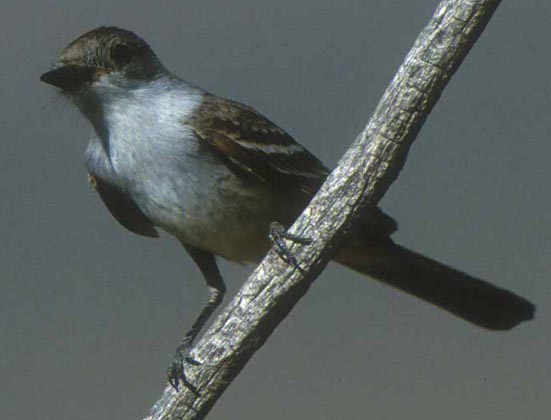 STRUCTURE:
To my eye, Ash-throated Flycatcher — shown in the photo (right) ©
Greg W. Lasley from the Davis Mountains of west Texas, taken 1 June — has
a long, rangy shape. Perhaps some of this is the longer wing (discussed
previously under "primary projection"), perhaps some is its overall mid-range
size (larger than small Myiarchus like Dusky-capped) and longish bill (bill
size hard to see in this angle), and perhaps part of it is posture.
STRUCTURE:
To my eye, Ash-throated Flycatcher — shown in the photo (right) ©
Greg W. Lasley from the Davis Mountains of west Texas, taken 1 June — has
a long, rangy shape. Perhaps some of this is the longer wing (discussed
previously under "primary projection"), perhaps some is its overall mid-range
size (larger than small Myiarchus like Dusky-capped) and longish bill (bill
size hard to see in this angle), and perhaps part of it is posture.
In contrast, Nutting's Flycatcher has a more compact shape, caused by
a combination of shorter bill (averages something like 10% shorter; see
measurements in Lanyon (1961); shorter wing, and comparative wing/tail
lengths. On Nutting's the wing length and tail length are typically the
same or the tail is less than 10% shorter than the wing (wing minus tail
statistics in Lanyon 1961, Pyle 1997) while all Ash-throateds have the
wing longer than the tail, and often by >10%. This is really a function
of the longer wing of Ash-throated. Whether any of this is useful in the
field is uncertain.
In any event, I wanted to compare the shape of the Santa Cruz bird to
the two known Nutting's, and I do so below, trying to pick photos of similar
posture from the selection that I have compiled from my own stuff and the
work of others. The top row below compares the Arizona bird (left; photo
© W. Ed Harper) to the Santa Cruz bird (right; © D. Roberson).
In the second row, I use the same Santa Cruz shot to compare with the southern
California bird (bottom right; © D. Roberson). However, in the top
row, I have used the "saturation" adjustment in PhotoShop to compensate
for a half-stop overexposed photo of the Santa Cruz bird. I think this
portrays its more natural color, but you can view both shots for your own
interpretation. This features does not change colors but just increases
the saturation of the colors that are there, rather as high-end film will
do. You can just for yourself whether the structure of the Santa Cruz bird
is similar to that of the Arizona (top left) or Orange County (bottom right)
birds.
Another thing I notice in this set of photos is apparent differences in
leg length and heft. To me the Ash-throated has longer-looking legs and
thicker legs than the known Nutting's. I can't find statistics or any discussion
of this character.
BILL SHAPE: As already briefly mentioned above, Nutting's averages
shorter-billed than Ash-throated. But there are other differences: (a)
the bill base is broad and, when combined with the shorter bill length,
looks proportionately broader than Ash-throated, and (b) the bill tends
to be thicker at the base than Ash-throated. Look for these points the
following set of photos. The top row is three different Ash-throateds (L
to R, © J.V. Remsen, May; © D. Roberson, April; © D. Roberson,
4 May — all from California). The middle row is photos of the Santa Cruz
bird (L to R, © K. McKereghan, next two © D. Roberson). The bottom
row are Nutting's (L to R, © W.E. Harper, Arizona [this photo has
been lightened while all others are unretouched for color], © D. Roberson,
Orange Co., and © Larry Sansone, Orange Co.). However, I have taken
the liberty of flipping the horizontal perspective to provide more effective
comparisons on a few shots.
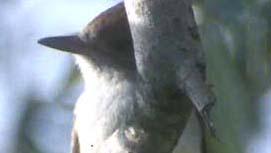 You
may compare this set of photos to develop your opinion on bill shape. I
have tried to show both length and depth (in profile shots) and width (in
angled shots or photos from above or below). Of course, there are other
photos on the web to use but do remember that your perspective of bill
size and shape requires both a decent angle of view (without significant
foreshortening) and a full view of the head (e.g., a bill sticking out
from a head that is partially obscured by limbs will be wildly out-of-perspective,
as illustrated by this shot of the Santa Cruz bird (right).
You
may compare this set of photos to develop your opinion on bill shape. I
have tried to show both length and depth (in profile shots) and width (in
angled shots or photos from above or below). Of course, there are other
photos on the web to use but do remember that your perspective of bill
size and shape requires both a decent angle of view (without significant
foreshortening) and a full view of the head (e.g., a bill sticking out
from a head that is partially obscured by limbs will be wildly out-of-perspective,
as illustrated by this shot of the Santa Cruz bird (right).
A final feature about the bills that you may notice is that the Nutting's
in both Arizona and southern California had pink at the base of the bill,
at the gape and along the cutting edge of the lower mandible. The Santa
Cruz bird also shows these characters, as can be seen in the Kevin McKereghan
photos and elsewhere on the web. This is not shown on the Ash-throated
photographs I have, but that sample is very limited. There have been comments
on chat lines that Ash-throated may show this, but I have yet to see it
documented.
The other pages in this project are:
LITERATURE CITED:
-
Bowers, R.K., Jr., and J.B. Dunning, Jr. 1987. Nutting's Flycatcher (Myiarchus
nuttingi) from Arizona. Amer. Birds 41:5-10.
-
Cardiff, S.W., and D.L. Dittmann. 2000. Brown-crested Flycatcher (Myiarchus
tyrannulus) in The Birds of North America, No. 496 (A. Poole
and F. Gill, eds.). The Birds of North America, Inc., Philadelphia, PA.
-
Cardiff, S.W., and D.L. Dittmann. 2002. Ash-throated Flycatcher (Myiarchus
cinerascens) in The Birds of North America, No. 664 (A. Poole
and F. Gill, eds.). The Birds of North America, Inc., Philadelphia, PA.
-
Devillers, P. 1971. The alleged occurrence of Nutting's Flycatcher in Baja
California. Calif. Birds 2:140.
-
Dickerman, R.W., and A.R. Phillips. 1953. First United States record of
Myiarchus nuttingi. Condor 55:101-102.
-
Dittmann, D.L., and S.W. Cardiff. 2000. Let's take another look: Myiarchus
flycatchers. LOS News 193:3-10. Louisiana Ornithol. Society, Baton Rouge.
-
Howell, S.N.G., and S. Webb. 1994. Field identification of Myiarchus
flycatchers in Mexico. Cotinga 2:20-25.
-
Howell, S.N.G., and S. Webb. 1995. A Guide to the Birds of Mexico and northern
Central America. Oxford Univ. Press, New York.
-
Lanyon, W.E. 1961. Specific limits and distribution of Ash-throated and
Nutting flycatchers. Condor 63:421-449.
-
Lanyon, W.E. 1997. Great Crested Flycatcher (Myiarchus crinitus)
in
The Birds of North America, No. 300 (A. Poole and F. Gill, eds.). The Birds
of North America, Inc., Philadelphia, PA.
-
Murphy, W.L. 1982. The Ash-throated Flycatcher in the East: an overview.
Amer. Birds 36:241-247.
-
National Geographic Society. 1999. Field Guide to the Birds of North America,
3rd ed. Nat. Geogr. Soc., Washington, D.C.
-
Phillips, A.R., and W.E. Lanyon. 1970. Additional notes on the flycatchers
of eastern North America. Bird-Banding 41:190-197.
-
Pyle, P. 1997. Identification Guide to North American Birds, Part I: Columbidae
to Ploceidae. Slate Creek Press, Bolinas, CA.
-
Zimmerman, D.A. 1978. A probable Nutting's Flycatcher in southwestern New
Mexico. West. Birds 9:135-136.
TOP
GO TO MONTEREY
COUNTY PAGE
GO TO HOME PAGE
GO TO
IDENTIFICATION PAGE
GO TO BIRDING THE
WORLD PAGE
GO TO BIRD FAMILIES
OF THE WORLD
Page created 26 Jan 2003
 STRUCTURE:
To my eye, Ash-throated Flycatcher — shown in the photo (right) ©
Greg W. Lasley from the Davis Mountains of west Texas, taken 1 June — has
a long, rangy shape. Perhaps some of this is the longer wing (discussed
previously under "primary projection"), perhaps some is its overall mid-range
size (larger than small Myiarchus like Dusky-capped) and longish bill (bill
size hard to see in this angle), and perhaps part of it is posture.
STRUCTURE:
To my eye, Ash-throated Flycatcher — shown in the photo (right) ©
Greg W. Lasley from the Davis Mountains of west Texas, taken 1 June — has
a long, rangy shape. Perhaps some of this is the longer wing (discussed
previously under "primary projection"), perhaps some is its overall mid-range
size (larger than small Myiarchus like Dusky-capped) and longish bill (bill
size hard to see in this angle), and perhaps part of it is posture.
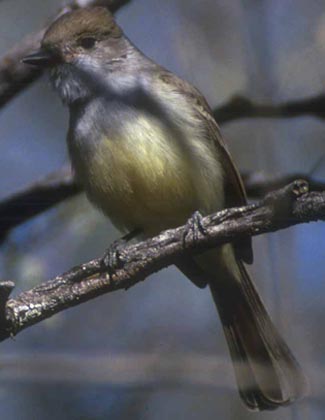
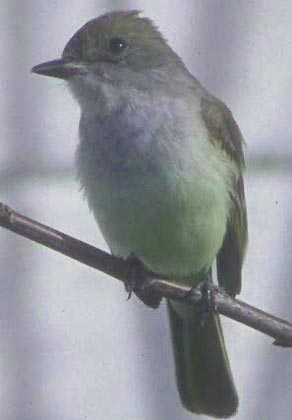

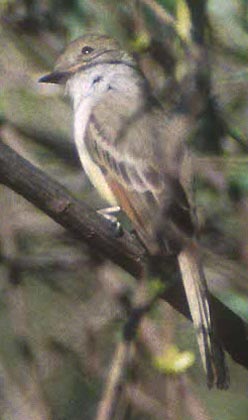
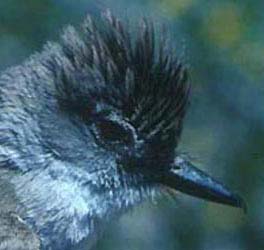
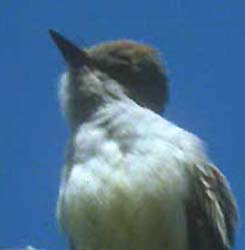
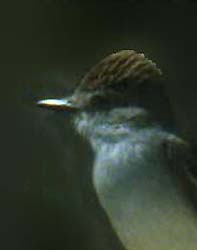
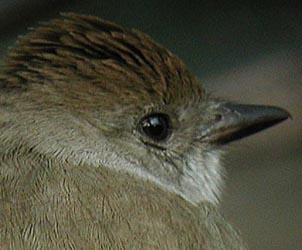
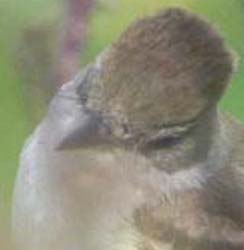
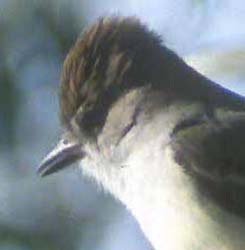
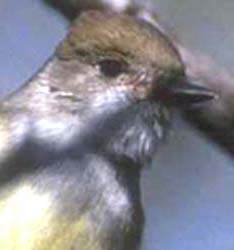
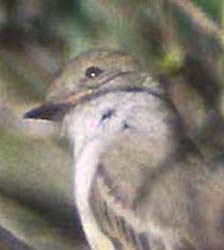
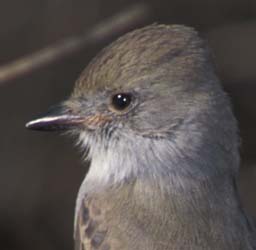
 You
may compare this set of photos to develop your opinion on bill shape. I
have tried to show both length and depth (in profile shots) and width (in
angled shots or photos from above or below). Of course, there are other
photos on the web to use but do remember that your perspective of bill
size and shape requires both a decent angle of view (without significant
foreshortening) and a full view of the head (e.g., a bill sticking out
from a head that is partially obscured by limbs will be wildly out-of-perspective,
as illustrated by this shot of the Santa Cruz bird (right).
You
may compare this set of photos to develop your opinion on bill shape. I
have tried to show both length and depth (in profile shots) and width (in
angled shots or photos from above or below). Of course, there are other
photos on the web to use but do remember that your perspective of bill
size and shape requires both a decent angle of view (without significant
foreshortening) and a full view of the head (e.g., a bill sticking out
from a head that is partially obscured by limbs will be wildly out-of-perspective,
as illustrated by this shot of the Santa Cruz bird (right).